Two identical billiard balls strike a rigid wall with the same speed but at different angles, and get reflected without any change in speed, as shown in figure. What is (i) the direction of the force on the wall due to each ball? (ii) the ratio of the magnitudes of impulses imparted to the balls by the wall ?
 Solution in Gujrati
Solution in Gujrati
Let mass of ball is
consider X and Y axis as shown in figure
Momentum p=mv
x component of final momentum
Similarly
component of inpulse of force
Impulse of force =-2 mu
Impulse and force are in same direction Hence force acting on ball due to wall is perpendicular to wall in - x direction by third law of motion to wall in + x direction
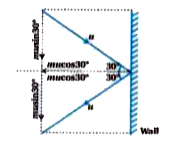
x component of momentum mucos
After collision X component of momentum are interchanged while component do not change x component of impulse of force
y= component of impulse of force
By taking ratio of impulse of force in (a) and ( b)
Topper's Solved these Questions
- LAW OF MOTIONBOOK - KUMAR PRAKASHANCHAPTER - LAW OF MOTIONEXERCISE - SECTION -B (NUMERICAL FROM TEXTUAL EXERCISE)
23 Videos
- LAW OF MOTIONBOOK - KUMAR PRAKASHANCHAPTER - LAW OF MOTIONEXERCISE - SECTION -B (ADDITIONAL EXERCISE )
17 Videos
- LAW OF MOTIONBOOK - KUMAR PRAKASHANCHAPTER - LAW OF MOTIONEXERCISE - SECTION-A(QUESTION PAPER)
39 Videos
- GRAVITATIONBOOK - KUMAR PRAKASHANCHAPTER - GRAVITATIONEXERCISE - QUESTIONS PAPER Section - D
1 Videos
- MACHANICAL PROPERTIES OF SOLIDS BOOK - KUMAR PRAKASHANCHAPTER - MACHANICAL PROPERTIES OF SOLIDS EXERCISE - QUESTION PAPER
11 Videos
Similar Questions
Give the magnitude and direction of the net force acting on (a) a drop of rain falling down with a constant speed, (b) a cork of mass 10 g floating on water, (c) a kite skillfully held stationary in the sky, (d) a car moving with a constant velocity of 30 km/h on a rough road, (e) a high-speed electron in space far from all material objects, and free of electric and magnetic fields.
View SolutionThe position-time graph of a body of mass 0.04 kg. Suggest a suitable physical context for this motion. What is the time between two consecutive impulses received by the body? What is the magnitude of each impulse ?

View SolutionWhat is dynamics?
View SolutionA spaceship is stationed on Mars. How much energy must be expended on the spaceship to launch it out of the solar system ? Mass of the spaceship = 1000 kg, mass of the sun =2×1030kg, mass of mars =6.4×1023kg, radius of mars = 3395 km, radius of the orbit of mars =2.28×108km,G=6.67×10−11Nm2kg2
View SolutionWhat is called brittle material ?
View SolutionAs shown in fig. two identical balls strike a rigid wall with equal speeds but a different angles of incidence. They are reflected back without any lose in speed.
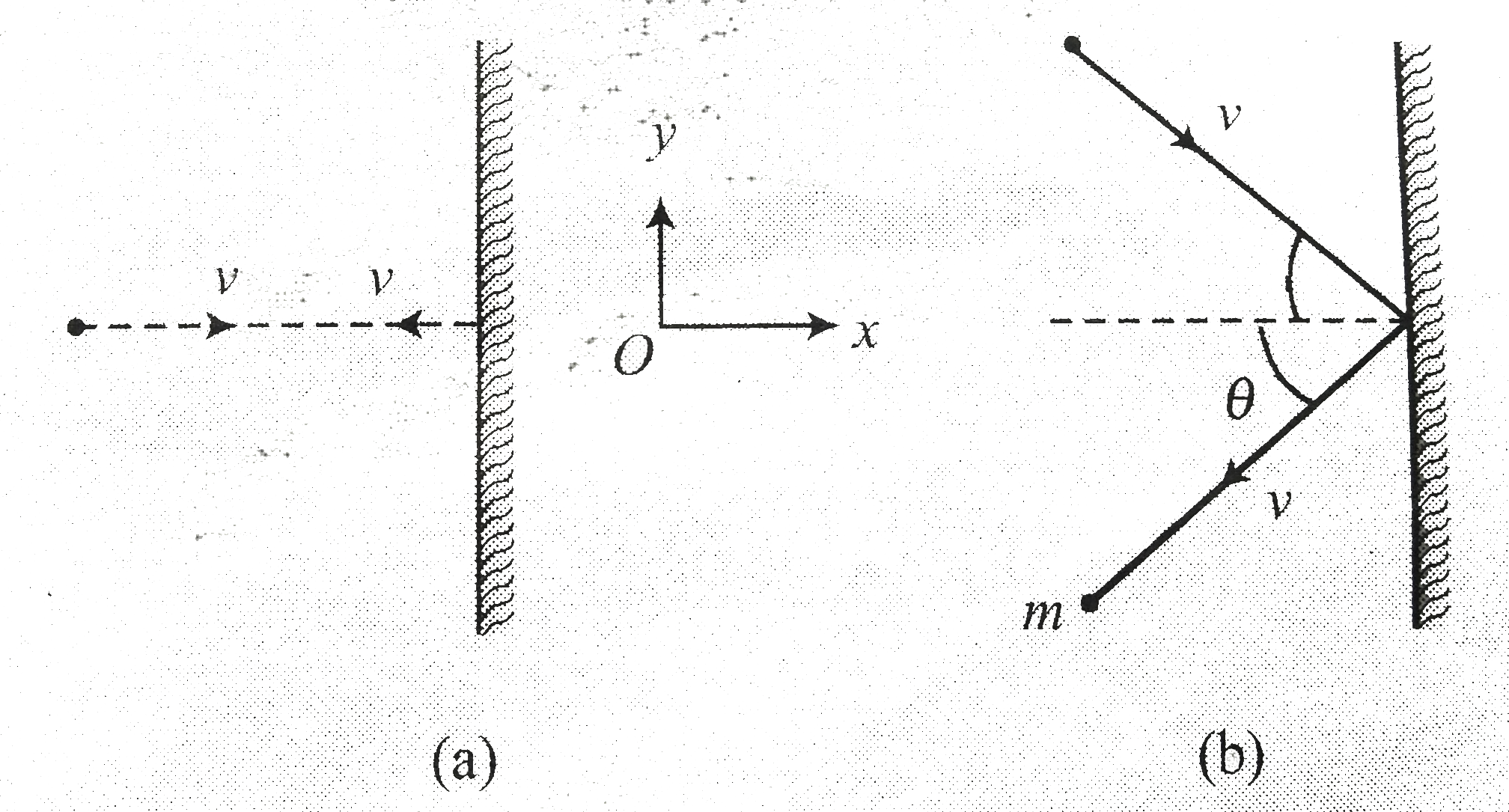

(a) Determine the direction of force exerted by each ball on the wall.
(b) Determine the ratio of impulse imparted by the two balls on the wall in both cases.
View SolutionTwo identical billiard balls striks a rigid wall with the same speed but at different angles , and get reflected without any change in speed , as shown in Fig . What is (i) the direction of the force on the wall due to each ball ? (ii) the ratio of the magnitudes of impulses imparted to the balls by the wall ?
View SolutionA rigid ball of mass m strikes a rigid wall at 60^(@) and gets reflected without loss of speed as shown in the figure. The value of impulse imparted by the wll on the ball will be
View Solutionदो सर्वसम बिलियर्ड गैंडे किसी दृढ़ दीवार से समान चाल से तुरंत भिन्न कोणों पर टकराती है तथा नीच दर्शये चित्र 5.6 की भांति चाल में बिना क्षय हुए परावर्तित हो जाती है । (i) प्रत्येक गेंद के कारण दीवार पर बल की दिशा क्या है ? तथा (ii) दीवार द्वारा दोनों गेंदोंपर लगे आवेगों का अनुपात क्या है?
View Solutionदो सर्वसम बिलियर्ड गेंदें किसी दृढ़ दीवार से समान चाल से , परंतु भिन्न कोनों पर टकराती है तथा नीचे दर्शाए चित्र की भाँति चाल में बिना क्षय हुए परावर्तित हो जाती है ।
(i) प्रत्येक गेंद के कारण दीवार पर बल की दिशा क्या है ? तथा (ii) दीवार द्वारा दोनों गेंदों पर लगे आवेगों का अनुपात क्या है ?
View SolutionA ball of mass m strikes a rigid wall with speed v and gets reflected without any loss of speed, as shown in the figure. (a) What is the magnitude of the impulse imparted to the ball by the wall? (b) What is the direction of the force on the wall due to the ball?
View SolutionTwo identical billiard balls strike a rigid wall with the same speed but at different angles, and get reflected without any change in speed, as shown in Fig. 5.6. What is (i) the direction of the force on the wall due to each ball? (ii) the ratio of the magnitudes of impulses imparted to the balls by the wall ?
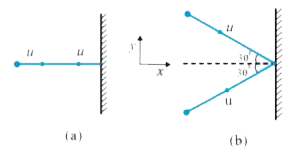
View SolutionTwo identical billiard balls strike a rigid wall with the same speed but at different angles, and get reflected without any change in speed, as shown in Fig. 5.6. What is (i) the direction of the force on the wall due to each ball? (ii) the ratio of the magnitudes of impulses imparted to the balls by the wall ?
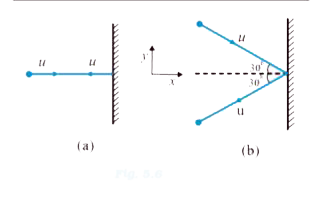
View SolutionThe speed of a car as a function of time as shown figure. Find the acceleration and distance travelled by the car in 8 seconds .
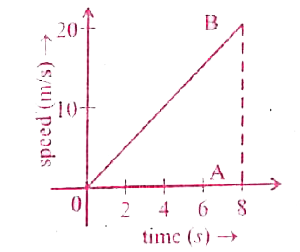
View SolutionTwo identical billiard balls striks a rigid wall with the same speed but at different angles , and get reflected without any change in speed , as shown in Fig . What is (i) the direction of the force on the wall due to each ball ? (ii) the ratio of the magnitudes of impulses imparted to the balls by the wall ?
View Solution
